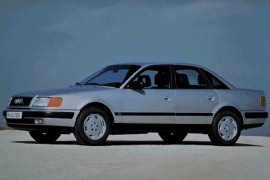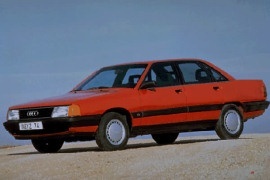
AUDI 100/ 200
Generations Timeline, Specs and Pictures

Audi launched a new (fourth) generation Audi 100/200 model in 1991.
Based on an entirely new Volkswagen Group C4 platform, the new Audi 100 was available to the large public in both saloon/sedan and estate/wagon variants.
The 100 sedan received new engine - 2.8L SOHC V6 petrol - while also featuring a ‘quattro’ permanent all-wheel-drive option across the range. When chosen, in came with a ZF 4-speed automatic gearbox. Despite being replaced by the A6 in 1995 (it was actually more of a re-designation of this model), the 100 continued to by produced under this design lines until 1997.

The first generation was released in 1968 and the nameplate of Audi 100 was assigned due to the engine’s power output of 100 hp.
A coupe version was also available and a 2-door saloon were also offered.
The Audi 100 released in 1982 was a mid-size 4-door luxury sedan, with a front engine and available with all-wheel-drive or front-wheel-drive system. The coupe version was discontinued and the Avant was introduced as a station wagon, with an available folding 3rd row.
The Audi 100 used a galvanized steel construction which ensured longevity and rust-resilience. The car featured the Audi’s Procon-Ten safety system, a feature that increased the driver’s protection in case of a front-crash, by pulling the dashboard and the steering wheel up and away from his face.
For 1982, the car was incredibly aerodynamic, with a drag coefficient of only 0.30, being the most aerodynamic car on sale at that time.
The Audi 100 was available with Audi’s Quattro AWD system. The car was available with 8 gasoline engines with a displacement between 1.8-liters to 2.3-liters developing power ranging between 75 to 165 hp.
The best acceleration was achieved by the Audi 100 2.2-liter Quattro, being able to reach 100 km/h in 8 seconds.
The Audi 100 represented a big step forward for the cars produced in the 90’s.

The Audi designers threw away all the other drawings from previous models when they started to work on the third generation of the Audi 100, and the result paid off.
When the third generation of the 100 was introduced in 1984, it was the most aerodynamic production car in the world. With a Cx drag-coefficient of just 0.30, it was better than any other sports car on the market, although the 100 was a four-door sedan, built for comfort and long journeys.
The squared second generation of the 100 was forgotten. The new design was aerodynamically enhanced up to the smallest exterior detail. The headlights were flush to the hood’s edge and with the wide grille. The windows were flush to the frames and the glued windshield didn’t make any turbulence. The 100 featured a flat hood, curved side panels, and a short and flat trunk lid. The 200 version featured enlarged wheel-arches to accommodate wider wheels.
Inside, the 100 offered a roomy cabin, fit for five passengers. Though, the rear center passenger had to stay on top of the transmission tunnel. The Audi 100 featured a different interior than its 200 sibling. The dashboard for the 100 featured a smaller instrument cluster, while the 200 version featured an extended version, to accommodate more dials. The central locking system was pneumatic. The 100 was the version bought mostly for family use, while the 200 was a direct hit against BMW, Mercedes-Benz, and Alfa Romeo on the premium segment.
The engine range was different for the twin models. While the 100 was offered with economical engines, the 200 range was offered exclusively with turbocharged units.

The second generation Audi 100 was developed on the Volkswagen Group C2 platform and was available for the large public starting 1976.
Initially available as either a 4-door saloon/sedan or a 2-door coupe model, the 100 received a new 5-door hatchback body style a year after its launch (called Avant). As for the Audi 100 sedan, it was a logical progression of the first generation model featuring a more roundish design and a brand new 5-cylinder inline engine configuration. This second generation Audi 100 was available on both the European and North American markets.

The 1968 Audi 100 was the beginning of a beautiful story of luxurious and fast sedans built by the German car-maker.
It was the first vehicle built together with Volkswagen.
The Audi 100 was developed on the Volkswagen C1 platform. There was a strange history behind the car, with a complex plot organized by Audi management to convince the Volkswagen Board to let them build an executive sedan. The four-round headlights, the slightly curved lines of the bodywork, and the spacious cabin rolled off the factory lane in 1968. It was a huge success and it was sold in almost 900.000 units until 1976 when it was replaced. The 100 name came from the power output of its top version.
Inside, the spacious 100 offered room for five adult passengers and ensured a comfortable ride. Unlike most of the other car-makers from that era, it featured a front-wheel-drive architecture. It meant that there was no transmission tunnel inside the vehicle. In the U.S. it was advertised as offering “just about the same headroom and legroom as the Rolls-Royce Silver Shadow”.
The engine range featured a 1.8- and 1.9-liter units. Most of them were feed via a carburetor, but in 1975 there was a fuel-injection system added to the lineup. The standard transmission was a 4-speed manual, with a 3-speed automatic joining the range later on. The in-board disc-brake system was another novelty, a technology inspired by the Porsche 917 race-car.























































